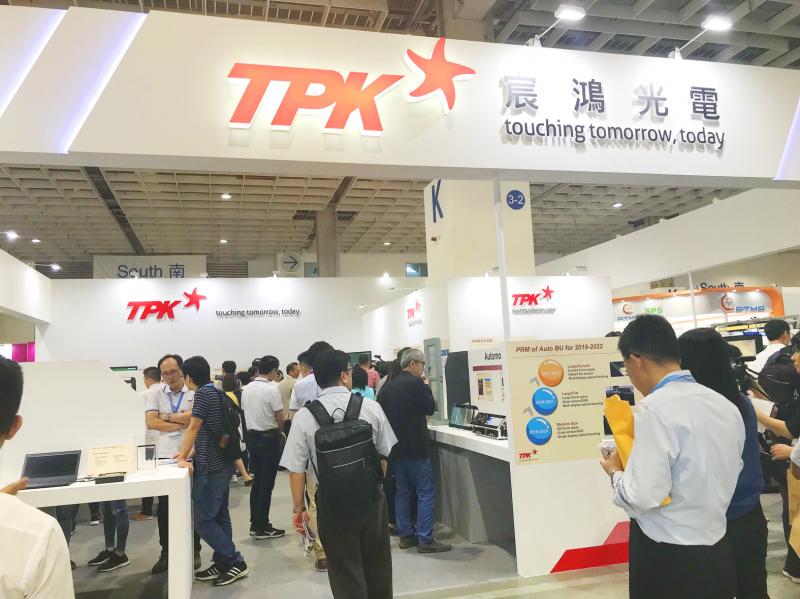Touch module and sensor supplier TPK Holding Co (宸鴻) yesterday gave a dismal revenue outlook for this quarter due to order losses.
Revenue is forecast to slump between 20 and 25 percent from NT$32.85 billion (US$1.14 billion) last quarter, TPK chief strategic officer Freddie Liu (劉詩亮) told investors in a teleconference.
Liu attributed the projected contraction mainly to a dearth of new orders.

Photo: Chen Mei-ying, Taipei Times
“As customers are monitoring how the COVID-19 pandemic will affect sales of end products over the next one to two months, we are conservative about the fourth-quarter outlook,” Liu said. “On top of that, the company is facing a product transition period, meaning new product output will not be as good as before.”
One of TPK’s clients has adjusted its specifications for smartphones and did not place orders for TPK’s touch display lamination services, Liu said.
As a result, TPK expects a continuous decline in revenue from the smartphone segment in the short to medium term, he said.
TPK’s revenue last month dipped 27.2 percent to NT$7.71 billion from NT$10.59 billion in September, and declined 46.7 percent compared with NT$14.48 billion a year earlier, he said.
The smartphone segment is the second-largest revenue source for TPK, making up 34 percent of its total revenue last quarter, a company financial statement showed.
The firm is seeking new business to fill the void over the next few quarters, Liu said.
TPK faces a mounting risk of weakening revenue due to a seasonal downturn, he said.
“The effect of the slow season is usually very severe,” he said.
The company expects to remain profitable this quarter through further improvement in operating efficiency and cost savings, Liu said.
Operating margin is expected to be between 0.5 and 1 percent this quarter, compared with 0.7 percent last quarter, he said.
TPK continues to benefit from growing demand for touch display solutions used in notebook computers and tablets amid remote working and online-learning trends due to the COVID-19 pandemic, TPK chief executive officer Leo Hsieh (謝立群) said.
“The growth momentum for tablets is quite healthy in the fourth quarter, mostly due to the pandemic,” Hsieh said.
The final quarter of the year is usually the peak season for tablets and laptops, he said.
TPK reported that net profit surged about 44 percent quarterly to NT$443 million last quarter, the highest in 10 quarters, boosted by NT$65 million in currency arbitrage gains.
On an annual basis, net profit skyrocketed 93.8 percent from NT$228 million.
Earnings per share jumped to NT$1.09 last quarter from NT$0.76 in the preceding quarter and NT$0.56 a year earlier.
Regular-sized tablets contributed 20 percent to TPK’s revenue last quarter, while notebook computers and larger tablets made up the biggest revenue share of 41 percent, the financial statement showed.

Micron Memory Taiwan Co (台灣美光), a subsidiary of US memorychip maker Micron Technology Inc, has been granted a NT$4.7 billion (US$149.5 million) subsidy under the Ministry of Economic Affairs A+ Corporate Innovation and R&D Enhancement program, the ministry said yesterday. The US memorychip maker’s program aims to back the development of high-performance and high-bandwidth memory chips with a total budget of NT$11.75 billion, the ministry said. Aside from the government funding, Micron is to inject the remaining investment of NT$7.06 billion as the company applied to participate the government’s Global Innovation Partnership Program to deepen technology cooperation, a ministry official told the

Taiwan Semiconductor Manufacturing Co (TSMC, 台積電), the world’s leading advanced chipmaker, officially began volume production of its 2-nanometer chips in the fourth quarter of this year, according to a recent update on the company’s Web site. The low-key announcement confirms that TSMC, the go-to chipmaker for artificial intelligence (AI) hardware providers Nvidia Corp and iPhone maker Apple Inc, met its original roadmap for the next-generation technology. Production is currently centered at Fab 22 in Kaohsiung, utilizing the company’s first-generation nanosheet transistor technology. The new architecture achieves “full-node strides in performance and power consumption,” TSMC said. The company described the 2nm process as

POTENTIAL demand: Tesla’s chance of reclaiming its leadership in EVs seems uncertain, but breakthrough in full self-driving could help boost sales, an analyst said Chinese auto giant BYD Co (比亞迪) is poised to surpass Tesla Inc as the world’s biggest electric vehicle (EV) company in annual sales. The two groups are expected to soon publish their final figures for this year, and based on sales data so far this year, there is almost no chance the US company led by CEO Elon Musk would retain its leadership position. As of the end of last month, BYD, which also produces hybrid vehicles, had sold 2.07 million EVs. Tesla, for its part, had sold 1.22 million by the end of September. Tesla’s September figures included a one-time boost in

Shares in Taiwan closed at a new high yesterday, the first trading day of the new year, as contract chipmaker Taiwan Semiconductor Manufacturing Co (TSMC, 台積電) continued to break records amid an artificial intelligence (AI) boom, dealers said. The TAIEX closed up 386.21 points, or 1.33 percent, at 29,349.81, with turnover totaling NT$648.844 billion (US$20.65 billion). “Judging from a stronger Taiwan dollar against the US dollar, I think foreign institutional investors returned from the holidays and brought funds into the local market,” Concord Securities Co (康和證券) analyst Kerry Huang (黃志祺) said. “Foreign investors just rebuilt their positions with TSMC as their top target,